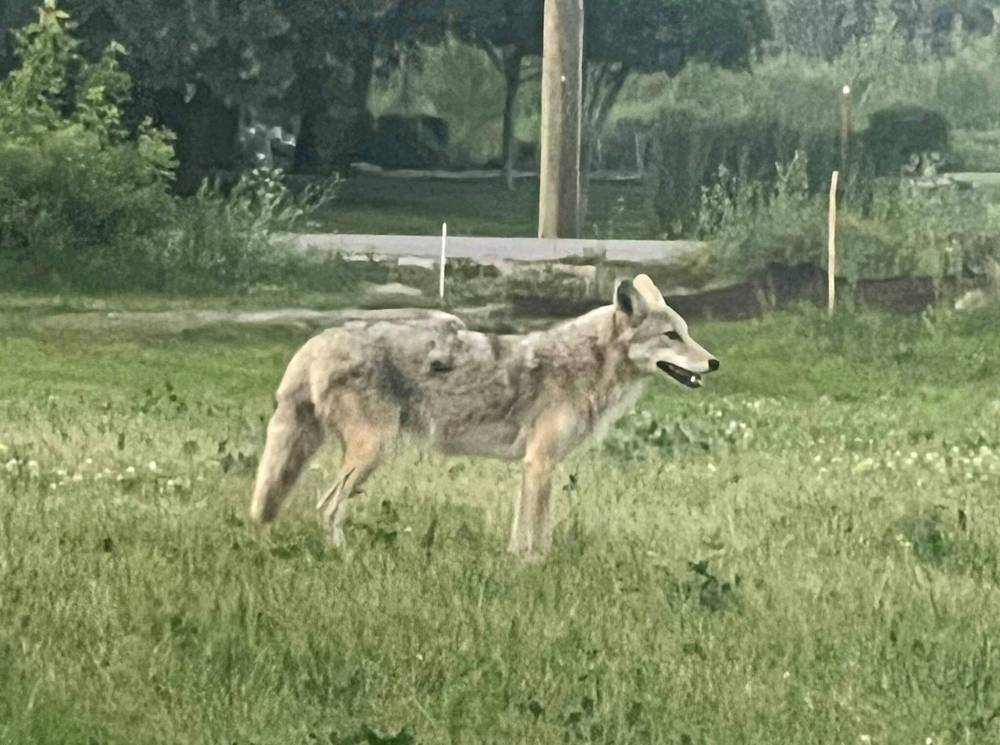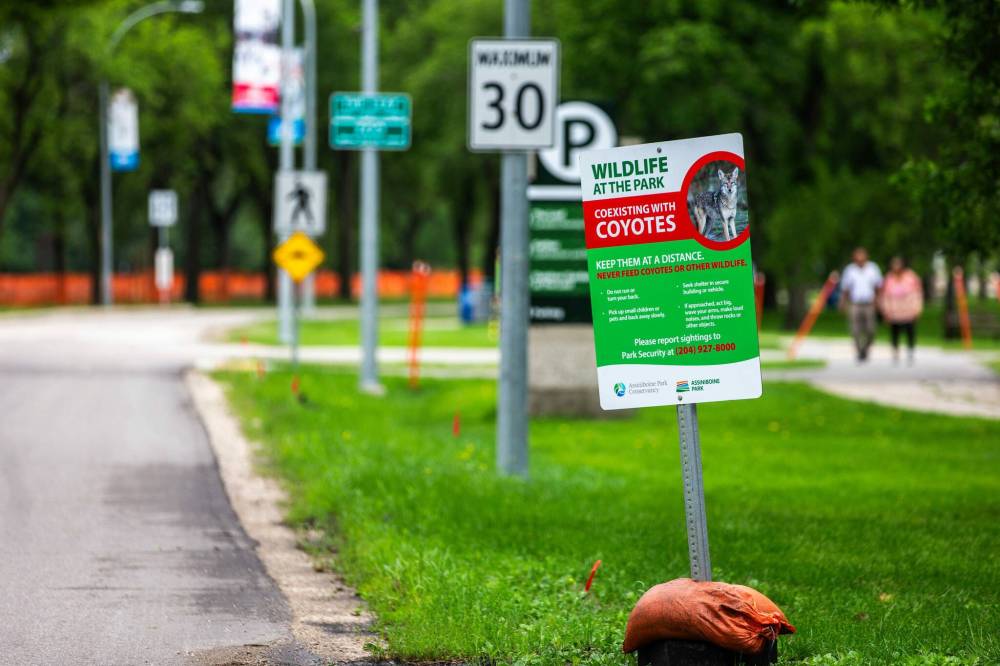Coyote sightings in Winnipeg have dropped since two children were attacked in summer 2023, but fears persist after a couple recently discovered a grisly scene in their neighbourhood.
Daniel and Helen Friesen were on an afternoon walk Saturday in Sandra Crowson Park near Pembina Highway when they spotted a deer carcass with its leg chewed off.
“It was right in the middle of the forest, right in a residential area,” Daniel Friesen said Monday.

Nikki Slater photo
Coyote sightings have dropped, but grisly evidence points to their continued presence.
Nikki Slater photo A coyote stands in an empty lot across from Olympic Park on Headmaster Row, just west of Lagimodiere Boulevard, on the evening of June 30, 2023.
It’s not the first time the Friesens have come across mangled deer bodies in their neighbourhood. They have seen deer that have been feasted on during walks though Crescent Drive Park. They also regularly see coyotes in the neighbourhood. Recently, Helen came face to face with a coyote — now she refuses to walk alone.
“Instead of walking away, it began to approach her,” Friesen said. “It just shouldn’t be that way that people have to restrict their activities on account of this kind of wildlife problem.”
Manitoba’s Conservation Officer Service saw the number of coyote-related calls double from 2022 to 2023 — to 677 from 355 — after two children were attacked by coyotes in July 2023.
In 2024, conservation logged 207 calls. There have been 15 so far in 2025. The province partially attributed the 2023 spike in reports to media attention surrounding the attacks.
In June 2023, a coyote chased and bit a nine-year-old boy in North Kildonan. A four-year-old was attacked in the same area less than a week later.
The incidents were believed to be the first recorded cases of coyote attacks on humans in Manitoba. The coyote was caught and euthanized shortly after.
Friesen said the province should be doubling down on its efforts to educate the public on feeding wildlife and live-trapping deer to take away food sources for coyotes.
“Move them out. Get rid of the food, and coyotes are going to find it less fun to be around,” he said.
A provincial spokesperson said due to the high number of vehicle collisions with deer in Winnipeg, it is not unusual for coyotes to be feeding on the bodies.
“In those particular cases, the carcass is typically removed by Manitoba Conservation staff, unless it has been fully consumed and no longer presents a food source,” the spokesperson said in an email.
Friesen also suggested the Manitoba Trapper’s Association conduct mass trappings of coyotes to help control populations within city limits.

MIKAELA MACKENZIE / FREE PRESS
Signs warn visitors of coyotes at Assiniboine Park last summer.
The province has a contract with the trappers association as part of the targeted predator removal program, which provides services to remove predators (coyote, wolf or fox) that have attacked livestock.
The association does not do targeted operations within Winnipeg. It was not available for comment Monday.
The province pointed to its Coexisting with Coyotes’ bulletin as a resource for people with questions about coyote populations migrating to urban centres.
Coyotes are adaptable animals that can be equally comfortable living in urban, rural and wilderness areas, the bulletin reads.
In July, the Bugs trail at Assiniboine Park Zoo was closed through the May long weekend after a coyote was seen in the area, postponing the new attraction that was set to open.
The conservancy later put up signage reminding parkgoers that coyotes live in the forestry of the park and not to feed them.
If a coyote is spotted: pick up kids and pets, back away slowly without running or turning your back and seek shelter. Should a coyote approach, make loud noises, wave your arms and throw objects, the signage states.
nicole.buffie@freepress.mb.ca

Nicole Buffie
Multimedia producer
Nicole Buffie is a multimedia producer who reports for the Free Press city desk. Born and bred in Winnipeg, Nicole graduated from Red River College’s Creative Communications program in 2020 and worked as a reporter throughout Manitoba before joining the Free Press newsroom in 2023. Read more about Nicole.
Every piece of reporting Nicole produces is reviewed by an editing team before it is posted online or published in print — part of the Free Press‘s tradition, since 1872, of producing reliable independent journalism. Read more about Free Press’s history and mandate, and learn how our newsroom operates.
Our newsroom depends on a growing audience of readers to power our journalism. If you are not a paid reader, please consider becoming a subscriber.
Our newsroom depends on its audience of readers to power our journalism. Thank you for your support.